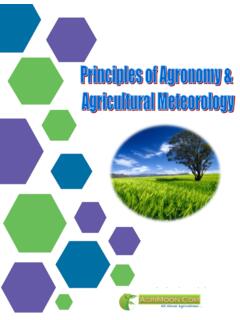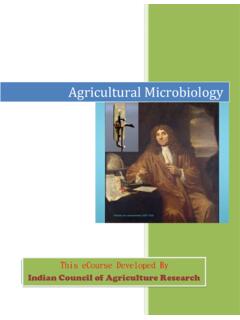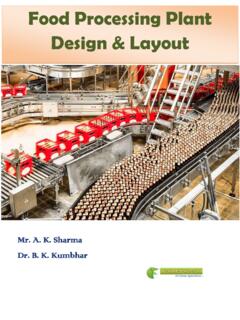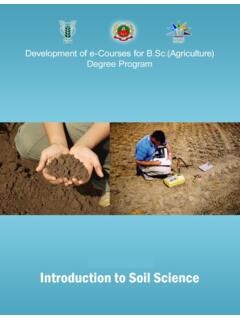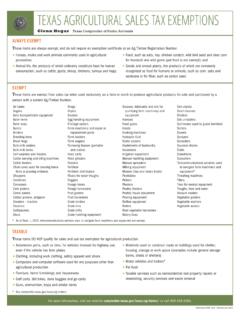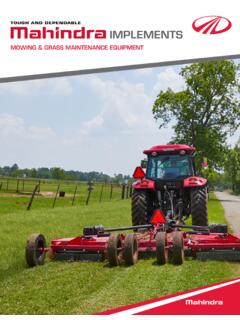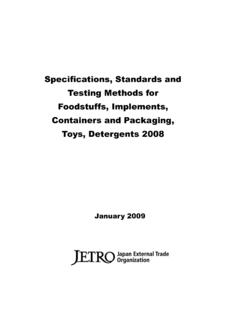Transcription of Agricultural Business Management - AgriMoon
1 Fundamentals of Agribusiness Management AECO 341 - Fundamentals of Agri Business Management (1+1) Author TNAU, Tamil Nadu Index Lecture Page No 1. Agribusiness 4-16 2. Small Business 17-28 3. Management 29-37 4. Planning 38-47 5. Organizing 48-63 6. Directing 64-71 7. Controlling 72-78 8. Production Management 79-92 9. Materials Management 93-100 10. Marketing Management 101-110 11. Personnel Management 111-119 12. Financial Management 120-133 13. Management information system 134-136 14. Government programmers and regulations for agribusiness 137-147 15. Agricultural inputs and agro-processing 148-157 Lecture 1 AGRIBUSINESS John H. Davis of Harvard University first used the term agribusiness in 1955. In 1980s it was given three connotations: (1) synonymous with term agriculture, (2) synonymous with Agricultural economics and (3) a modified concept of agriculture, excluding farming, or the off-farm aspects of agriculture.
2 At present, agribusiness is defined as all Business enterprises or sells to farmers / traders / consumers. The transaction may involve either an input or a produce or service and encompasses items such as: 1) Productive resources (feed, seed, fertilizer, equipment, energy, pesticides, machinery, etc.) 2) Agricultural commodities (raw and processed commodities of food and fiber) 3) Facilitative services (credit, insurance, marketing, storage, processing, transportation, packing, distribution, consultancy, soil testing etc.). Scope for Agribusiness in India 1. India is endowed with varied ago-climate, which facilitates production of temperate, sub-tropical and tropical Agricultural commodities. 2. There is growing demand for Agricultural inputs like feed and fodder, inorganic fertilizers, bio-fertilizers. 3. Biotechnology applications in agriculture have vast scope in production of seed, bio-control agents, industrial harnessing of microbes for bakery products.
3 4. Export can be harnessed as a source of economic growth. As a signatory of World Trade Organization, India has vast potential to improve it present position in the World trade of Agricultural commodities both raw and processed form. The products line include cereals, pulses, oilseeds and oils, oil meal, spices and condiments, fruits and vegetables, flowers, medicinal plants and essential oils, Agricultural Fundamentals of AgriBusiness advisory services, Agricultural tools and implements, meat, milk and milk products, fish and fish products, ornamental fish, forest by products etc. 5. At present processing is done at primary level only and the rising standard of living expands opportunities for secondary and tertiary processing of Agricultural commodities. 6. The vast coastal line and internal water courses provides enormous opportunity for production of marine and inland fish and ornamental fish culture gaining popularity with increase in aesthetic value among the citizens of 7.
4 The livestock wealth gives enormous scope for production of meat, milk and milk products, poultry products etc 8. The forest resources can be utilized for production of by products of forestry. 9. Beekeeping and apiary can be taken up on large scale in India. 10. Mushroom production for domestic consumption and export can be enhanced with improvement in the state of art of their production. 11. Organic farming has highest potential in India as the pesticide and inorganic fertilizer application are less in India compared to industrial nations of the world. The farmers can be encouraged and educated to switch over for organic farming. 12. There is wide scope for production and promotion of bio-pesticides and bio-control agents for protection of crops. 13. Seeds, hybrid and genetically modified crops, have the highest potential in India in the future, since the productivity of high yielding varieties have reached a plateau.
5 14. Micro-irrigation systems and labor saving farm equipments have good potential for the years to come due to declining groundwater level and labor scarcity for Agricultural operations like weeding, transplanting and harvesting. 15. Production of vegetables and flowers under green house conditions can be taken up to harness the export market. Fundamentals of AgriBusiness 16. Trained human resources in agriculture and allied sciences will take on Agricultural extension system due to dwindling resources of state finance and down sizing the present government Agricultural extension staff as consulting sevices. 17. The enhanced Agricultural production throws open opportunities for employment in marketing, transport, cold storage and warehousing facilities, credit, insurance and logistic support services.
6 Types of Small Businesses With the exception of Government, most of the small businesses can be classified as the following types 1) Production 2) Retailing 3) Distribution 4) Personal services 5) Professional services 6) Financial 7) Franchising 1. Production: This classification includes all types of production including Agricultural production of crops and livestock , as well as forestry. 2. Distribution: This classification refers to those businesses, which do not make anything but which bring the goods and services to the consumer or user. This includes such activities as packaging, labeling, transporting, refrigerating, freezing, processing, storing, and performing any service necessary to prepare the goods or to provide the service to eventual consumer. 3. Retailing: Although often included as a phase of distribution, retailing is listed as a separate category because there are a large number of persons employed in retailing.
7 Obviously it represents one of the best Fundamentals of AgriBusiness opportunities for the potential entrepreneur. Retailing is that stage of distribution, which deals with the consumers. Examples of retailers are grocers, self-service sores, florists, Agricultural input retailing. 4. Personal services: The service Business is those, which do not primarily supply goods to the public, but instead perform a service. Goods may be used to perform the service but they are of secondary importance. Examples of personal service are hotels, restaurants, agro-service centers. 5. Professional services: Some type of services, in order to protect the public, requires considerable training on the part of those offering the service. Usually those professional services must have a formal education and rigid examinations before receiving licenses to offer their services to the public.
8 Examples of those offering services are investment brokers, insurance agents etc. 6. Financial: Financial businesses are usually service-oriented but since they deal primarily with the loaning or investing of money or the equivalents of money (stocks, bonds, property rights, etc) a separate category describes them best. Examples of financial services are commercial banks, insurance companies, thrift and loan societies etc. : Franchising is a system for selectively distributing goods or services through outlets owned by the franchisee. Basically, a franchise is a patent or trademark, license, entitling the holder to market particular products or services under a brand name or trademark according to prearranged terms and conditions. The franchiser is the owner of his or her own Business ( the franchisee) is likely to be more diligent and strive harder for success than the hired manager of a company-owned outlet.
9 Since franchising is form of selective distribution, the typical franchise agreement prohibits the franchise from setting up competing outlets within the franchise area. Examples of franchise services are diet services, quick-service food-drive inns like fried chicken. Forms of the Business Organizations There are three basic forms of Business organization methods: the sole proprietorship, the partnership, and the corporation. With only a few limited exceptions, any type of Business venture can use nay form of Business organization. The factors that will affect the Business form chosen are: Fundamentals of AgriBusiness 1. Ease of formation 2. Exposure to financial risk 3. Ability to raise capital 4. Tax treatment of income 5. Continuity of Business upon the death of owner. Fundamentals of AgriBusiness A comparison of the three forms of Business organization FACTORS SOLE PROPREITORSHIP PARTNERSHIP CORPORATION Number of owners One Two or more One or more Ease of formation Very easy Easy to very easy Moderate to easy Degree of financial risk Owner is responsible for all debts Partners share responsibility for debts Owners have only limited responsibility for debts in name of company Ability to borrow funds Limited ability of owner to borrow Improved ability to borrow due to multiple owners Can borrow funds directly from public through shares and debentures Legal requirements None, except for possible declaration of name Same as sole proprietorship.
10 Written contract between partners recommended Charter must be secured from state How taxes are handled As part of owner s personal tax return Profits are divided up among owners and are taxed on each partner s tax return Pays own income tax Continuity of Business Business is terminated at death of owner Business may be terminated at death of any partner, unless provisions for continuation are made Business continues after death of any stockholder Entrepreneur Many economic theories emphasize the significant role played by individual entrepreneurs as they combine talents, abilities and drive to transform resources into profitable undertakings. Joseph Schumpeter, was the Fundamentals of AgriBusiness first major writer to highlight the human agent in the process of economic development. He believed that the economy was propelled by the activities of persons who wanted to promote new goods and new methods of productions or to exploit a new source of materials or new market not merely for profit but also for the purpose of creating.
